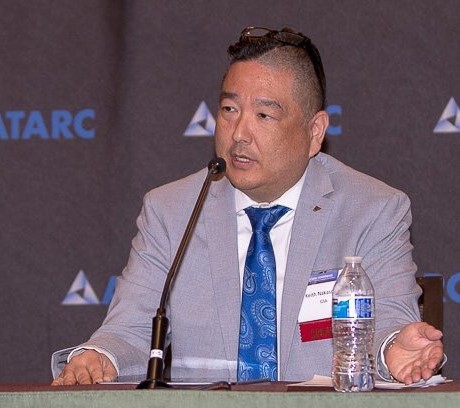
GSA kick starts 2021 with an acquisition potpourri
The General Services Administration is keeping contractors on their toes with the release of three acquisition initiatives — Polaris, the new small business...
When it comes to federal procurement, the General Services Administration takes no off days.
While the GSA’s Federal Acquisition Service employees will never be mistaken for elite athletes — where this concept of no days off comes from — they aren’t wasting any time setting up 2021 to be a busy year for contractors and for new governmentwide acquisition contracts.
In the span of two weeks, GSA released the draft solicitation for Polaris, the small business GWAC to replace the debacle that was Alliant 2 Small Business as well as two requests for information — one for artificial intelligence and machine learning capabilities, and one to develop a new professional services vehicle.
These initial pieces of market research or acquisition strategy planning come as GSA already is reviewing bids for spots under the 8(a) STARS III GWAC and the ASTRO program. GSA expects to make awards for both of these programs in spring 2021 or thereabouts.
“We are looking at fiscal 2021 at being the year where we see some big awards,” said Laura Stanton, FAS’ assistant commissioner for the Office of Information Technology Category, during a recent event sponsored by ACT-IAC. “In fiscal 2020, the IT category facilitated more than $30 billion in annual government spend. We still are wrapping up those year-end numbers, but it represents the trust the federal agencies have put in us, the customer service, the support is reducing the procurement action lead time, innovation and data transparency and all of the things the agencies put their trust in ITC to make that happen. Out of that, we also provided more than $2 billion in savings and cost avoidance for the customers of ITC alone.”
Just for comparison, in 2019, the IT category saw about $26.5 billion in spending, which means FAS saw a 15% growth rate.
“Some of the growth in 2020 is likely from COVID and some of it is from use of best-in-class contracts and spend under management,” Staunton said.
Polaris, 8(a) STARS III, ASTRO and several other initiatives like the commercial platform, the 2GIT vehicle and OASIS with all the new vendors are slated to gain momentum in 2021 means GSA will continue to capture more of the market.
There are several interesting aspects to the Polaris draft request for proposals starting off with its use of the Section 876 authority. GSA is not using price as an evaluation factor at the master contract level, meaning price only matters for each individual task order.
Driving competition down to the task order level has been a key priority for out-going Administrator Emily Murphy during her tenure. With ASTRO first and now with Polaris, it seems the tide is starting to turn.
Another factor in Polaris is its call out of the Cybersecurity Maturity Model Certification (CMMC) standards. While the GWAC doesn’t require CMMC certification, GSA is asking vendors to become accredited.
Keith Nakasone, the deputy assistant commissioner for IT Acquisition in FAS’ ITC, said at the recent ACT-IAC event that vendors must move from self-attestation to a more rigorous review of components and parts.

“We are embedding the language in the GWAC. The level of certification will come in at the order level, meaning vendors don’t have to be certified at the master contract level. It’s going to be based on the orders that come through the GWAC,” he said. “We included the CMMC language within the master level so it’s within scope. At the order level, agencies can add additional requirements for levels 1-5 depending on their mission requirements. We want to leave that flexibility in the mission program and learn over time alongside with the Defense Department.”
GSA’s goal with Polaris, which has no maximum dollar ceiling, is to promote innovation through the seven technology performance areas that include cloud, cybersecurity, data management and software development.
“The contractor should approach agency task order requirements with technical proposals offering innovative solutions that leverage the flexibility provided by the master contract,” the draft RFP stated. “The choice to align the master contract scope with Technology Business Management (TBM) [standards] and the definitions of IT allows for the adoption of new technologies and innovative solution approaches as they evolve over the life of the contract. The government also encourages the contractor to continuously prospect for and establish strategic relationships, especially with innovative small businesses, to meet this objective.”
Polaris plans to make awards to three pools of vendors — small businesses, women-owned small businesses and Historically-underutilized Business Zone (HUBZone) small firms. Comments on the draft RFP are due by Jan. 29.
Two RFIs released
Innovation seems to be a common theme across GSA acquisition efforts.
The AI/ML RFI is asking product and service vendors for feedback on current capabilities, contracts already offering these technologies and agencies or sectors that already are using the products or services.
“We are taking these forward leaning approaches so that we can adopt technology as well as provide what we know today and inject future technology moving forward,” Nakasone said.
Responses to the RFI are due Jan 29.
“We are keeping technology offerings that work currently on GWACS, but we are making some tweaks to emphasize emerging technologies like AI, edge computing and ‘anything as-a-service’ so customer agencies can tap into the small companies that provide these expertise to drive further IT modernization and improve service delivery,” said Allen Hill, the acting deputy assistant commissioner for category management in FAS.
Finally, the new professional services effort may not be considered a formal RFI, but FAS is working with ACT-IAC to hold listening sessions with vendors in early February.
“The next generation services IDIQ will seek to combine features such as unpriced master contracts, small business set asides, vetted and open enrollment with all order types including firm fixed price, cost-type, time and materials and hybrids into one centrally managed, user friendly structure,” GSA wrote in a fact sheet. “The goal is to complete an acquisition strategy that achieves the outlined objectives for this new contract program by fiscal 2021 end. After the acquisition strategy is completed our plan is to issue the solicitation in fiscal 2022, with awards and contract use beginning in fiscal 2023.”
New services marketplace
Tiffany Hixson, the assistant commissioner for the professional services and human capital categories at FAS, said at the recent Coalition for Government Procurement conference, that this effort is part of a new services marketplace will bring together several different work streams.

She said there are three goals:
- Rationalize, align and expand our multiple award contract, GWAC and schedule offerings. “Sometimes they work well together and sometimes no so much. We recognize that so our teams are going to be working to try to get them to work together a little more cohesively,” Hixson said.
- Improve FAS’ market research and buying tools for federal acquisition professionals. She said GSA plans to rationalize the assortment of digital tools and support the services contracts better than current digital tools do.
- Improve FAS’ data and reporting systems. She said many of those systems that industry uses need to be improved.
“The OASIS ordering period expires in 2024 so we are asking ‘what’s next?’ We will be talking to the federal acquisition community and industry about what that next is. We are beginning our formal market research and planning for what the next generation contract and best-in-class contract will be in government,” Hixson said. “Internal to the organization, we are formally establishing a collaborative community with in FAS so we are working on services contracts more holistically and thinking about how to better provide those services contract needs.”
Professional services is among the largest growth areas for FAS. Hixson said usage of all services contracts under her portfolio grew 9.5% year over year, which meant $1.78 billion more sales in 2020. She said the biggest drivers were schedules contracts growing 11% and OASIS, which increased by 7% over 2019. Schedules sales outpaced OASIS for the first time in the last few years.
“Our five-year growth for all contract programs and that includes the human capital services programs, including HCATs and schedules, has been 60% over the last five years. In 2016, it was about $13 billion in business volume and in 2020, we had $21 billion in business volume,” she said. “For us, while the number is big, the important part of that message is our contracts are meeting the needs of the federal community.”
GSA is starting at the right place by listening and learning from its federal agency and industry customers because OASIS and the schedule contract for services have been highly successful so the goal is to make them better, not just mess with a good thing.
Copyright © 2025 Federal News Network. All rights reserved. This website is not intended for users located within the European Economic Area.
Jason Miller is executive editor of Federal News Network and directs news coverage on the people, policy and programs of the federal government.
Follow @jmillerWFED
Related Stories

Cancellation of Alliant 2 Small Business caps a rough few months for small firms

GSA FAS update: E-commerce marketplace back on, Alliant 2 small business details coming




